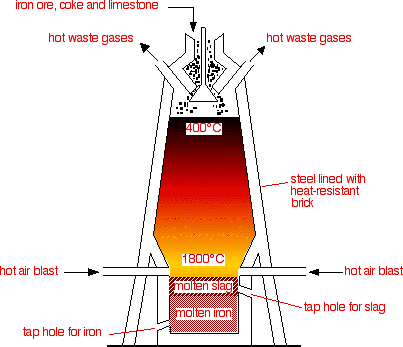| Introduction The common ores of iron are both iron oxides, and these can be reduced to iron by heating them with carbon in the form of coke. Coke is produced by heating coal in the absence of air. Coke is cheap and provides both the reducing agent for the reaction and also the heat source - as you will see below. Iron ores The most commonly used iron ores are haematite (US: hematite), Fe2O3, and magnetite, Fe3O4. | |
Note: The two equations for the reduction of the ore on this page are for haematite. In the fairly unlikely event that you need the equations for magnetite, they aren't difficult to work out for yourself. | |
The Blast Furnace The heat source The air blown into the bottom of the furnace is heated using the hot waste gases from the top. Heat energy is valuable, and it is important not to waste any. The coke (essentially impure carbon) burns in the blast of hot air to form carbon dioxide - a strongly exothermic reaction. This reaction is the main source of heat in the furnace. The reduction of the ore At the high temperature at the bottom of the furnace, carbon dioxide reacts with carbon to produce carbon monoxide. It is the carbon monoxide which is the main reducing agent in the furnace. In the hotter parts of the furnace, the carbon itself also acts as a reducing agent. Notice that at these temperatures, the other product of the reaction is carbon monoxide, not carbon dioxide. The temperature of the furnace is hot enough to melt the iron which trickles down to the bottom where it can be tapped off. The function of the limestone Iron ore isn't pure iron oxide - it also contains an assortment of rocky material. This wouldn't melt at the temperature of the furnace, and would eventually clog it up. The limestone is added to convert this into slag which melts and runs to the bottom. The heat of the furnace decomposes the limestone to give calcium oxide. This is an endothermic reaction, absorbing heat from the furnace. It is therefore important not to add too much limestone because it would otherwise cool the furnace. Calcium oxide is a basic oxide and reacts with acidic oxides such as silicon dioxide present in the rock. Calcium oxide reacts with silicon dioxide to give calcium silicate. The calcium silicate melts and runs down through the furnace to form a layer on top of the molten iron. It can be tapped off from time to time as slag. Slag is used in road making and as "slag cement" - a final ground slag which can be used in cement, often mixed with Portland cement. | |
Wednesday, 3 August 2011
Extracting iron from iron ore using a Blast Furnace
Subscribe to:
Post Comments (Atom)
No comments:
Post a Comment